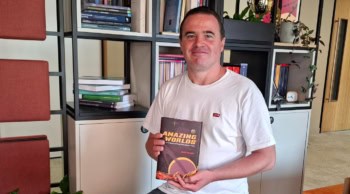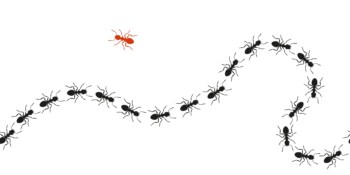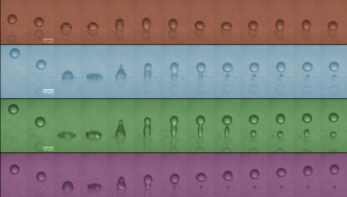Projects designed to bring artists and scientists together are becoming ever more popular. Edwin Cartlidge finds out why
“Science is more controversial than art can ever be.” Strange words for an artist, perhaps, but Cornelia Parker has been inspired by science for many years. Indeed, Parker’s “Cold, dark matter” – the suspended remains of a garden shed that the army blew up on her behalf – is currently on show at the recently opened Tate Modern gallery in London.
Parker is one of a growing number of artists who have realized that science is fertile territory for the imagination. Of course, in the past painters and sculptors such as Leonardo da Vinci were active in science, but in an otherwise increasingly specialized world, more and more contemporary artists are linking up with scientists.
One of the many new collaborations is centred around CERN, the European laboratory for particle physics in Geneva. CERN is collaborating with the London Institute, the world’s largest college of art, design and communication, on a project called “Signatures of the invisible”. Leading European artists, including Turner prize-winners Richard Deacon and Anish Kapoor, will spend up to two months working with physicists from CERN to create works of art that will be shown in major galleries around the world.
Common beauty
So what does CERN hope to gain from the collaboration? “I am a strong believer in bringing people together over obvious divides in order to weaken those divides, be they political or cultural,” says Maurice Jacob, former head of the lab’s theory division and one of the founders of the project. “There are many obvious differences between art and science,” he says, “but also many common points.”
One of the artists involved in “Signatures of the invisible”, Monica Sand from Sweden, has been collaborating with CERN for the past eight years, and has mounted several exhibitions of sculptures that incorporate research results. “My main interest is space, and how light shapes space,” she says.
In a work called “Traces” Sand explores the idea that an elementary particle is never seen directly. Instead, physicists infer the existence of an elementary particle from the traces of other particles that have been disturbed in its wake. “How is one to know which knowledge is required to interpret the traces?” she asks. She explores the question through sculpture made from materials used to track particles – scintillators and wavelength shifters.
“Science and art are two different approaches that complement each other, and [both] are needed to produce a balanced vision of the world,” says physicist and science writer F David Peat. “They also have much in common. Science is very much directed by aesthetics and beauty – notions of what fits, economy of means, and ideas of form and order. The same issues surface, in different ways, in art.” But there are differences. “Science boasts of being objective and value free,” Peat says, “while art is concerned with value and human response.”
Peat has collaborated with a number of artists, including Anthony Gormley and David Hockney. “These people think deeply about issues that also interest scientists,” he says. “But the fact that they are not scientists is what is important, because they bring a different perspective.”
Sentimental rubbish?
Cornelia Parker’s irreverent style appealed to Nature editor Philip Campbell, who discreetly inserted images of her work into the magazine to see how readers would react. One of the images looked like an electron micrograph but was, in fact, a close up of the grooves on a record owned by Hitler. Campbell admits that Parker’s work did not cause the stir he was hoping for because it actually blended in too well. Nevertheless he subsequently published a series of articles on art and science by art-historian Martin Kemp and would like to see more art on the pages of Nature in the future.
Such link ups between art and science are important, says Ken Arnold of the biomedical research charity the Wellcome Trust. He feels that collaborations lead to greater self-awareness in scientists and artists through the need to explain things to someone with a different intellectual viewpoint.
Wellcome runs a “SciArt” scheme to encourage artists and scientists to “look beyond the traditional boundaries of their professions for mutual benefit”. This year it awarded 11 grants totalling £200 000. Arnold believes that the projects funded by Wellcome should also encourage the public appreciation of science.
But not everyone is so enthusiastic. “Absolute junk. Sentimental rubbish,” says biologist and media science pundit, Lewis Wolpert. “To say there is a lot in common between science and art is rubbish. We can say that we understand biology better than we did 30 years ago, but there is no such thing as progress in art.”
Nor is art a good way to promote science, according to Wolpert: “Anyone else – playwrights, writers, bankers – could improve the public understanding of science, but not artists. If you want to help art, then sure, bring in science. But nothing will happen the other way around.” He adds that he cannot think of a single instance in which art has helped the creative process in science. Not surprisingly, Wolpert “attacks the Wellcome Trust constantly” over the money it spends on the SciArt scheme.
Peat, however, makes the claim that the American artist Charles Biederman provided the late David Bohm with insights into physics. “Bohm was seeking a new order to physics, one compatible with quantum theory,” says Peat. “He rejected the old ‘Cartesian order’ based on points in a continuous space and looked instead to algebraic and topological structures.”
For many years Bohm exchanged ideas with Biederman, who was interested in structure and order in art and who studied Cezanne’s paintings extensively. “Bohm once said that if he could only describe such a painting in mathematical terms, it would be the exact mathematics he needed for quantum theory,” says Peat.
In another case of art leading science, the painter
Geometric art
Maths and physics also come together with art in the work of Simon Thomas, a sculptor who is interested in exploring “the efficiencies of space”. Thomas was artist-in-residence in the physics department at Bristol University for two years and is currently working on a cone-like sculpture in honour of Paul Dirac. The sculpture, which was commissioned by Institute of Physics Publishing (the publishers of Physics World), will sit outside the @Bristol science centre. Built up from layers of crosses that become progressively shallower, the sculpture poses the question: what happens when we get to the Planck scale?
Thomas has also collaborated with the mathematicians Andy Burbanks and Neil O’Connell at Hewlett-Packard in Bristol on a project to explore the interface between maths and art. In the course of the project, Thomas tried to develop a “more analytical approach” to art, and created a set of geometric sculptures that were later distributed around the research labs.
Jeremy Gunawardena, director of Hewlett-Packard’s Basic Research Institute in Mathematics, says the $75 000 project was well worth the money and that it helped to break down the “tunnel vision” that takes hold in research labs. “People have been surprised at how well the project has worked,” he says. “Having the sculptures has created a different feeling in the building. It makes you realize that we live in a much more complex space than just a technology lab. Art and aesthetics are important.”
But not all collaborations between artists and scientists will meet with such success. F David Peat, for instance, thinks that art-science collaborations are becoming too fashionable and that a lot of money is being poured into the field to produce what are only mediocre results.
Ken Arnold at Wellcome agrees that a lot of work in this area is not very good, and predicts that art-science projects will become less popular in the future. However, he thinks that is important for specialists to be able to “peer into” other disciplines.
“We live in a specialist world,” says Arnold. “The idea that we can return to the Renaissance is foolhardy. But hopefully in the future we will have more open-minded scientists and artists.”



